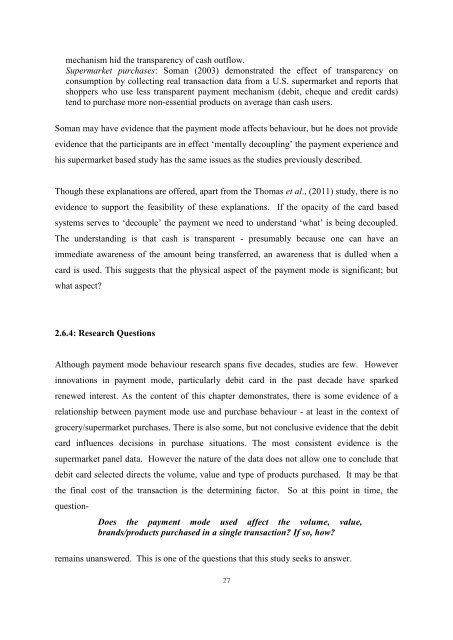Cash or Card: Consumer Perceptions of Payment Modes - Scholarly ...
Cash or Card: Consumer Perceptions of Payment Modes - Scholarly ...
Cash or Card: Consumer Perceptions of Payment Modes - Scholarly ...
Create successful ePaper yourself
Turn your PDF publications into a flip-book with our unique Google optimized e-Paper software.
mechanism hid the transparency <strong>of</strong> cash outflow.<br />
Supermarket purchases: Soman (2003) demonstrated the effect <strong>of</strong> transparency on<br />
consumption by collecting real transaction data from a U.S. supermarket and rep<strong>or</strong>ts that<br />
shoppers who use less transparent payment mechanism (debit, cheque and credit cards)<br />
tend to purchase m<strong>or</strong>e non-essential products on average than cash users.<br />
Soman may have evidence that the payment mode affects behaviour, but he does not provide<br />
evidence that the participants are in effect ‘mentally decoupling’ the payment experience and<br />
his supermarket based study has the same issues as the studies previously described.<br />
Though these explanations are <strong>of</strong>fered, apart from the Thomas et al., (2011) study, there is no<br />
evidence to supp<strong>or</strong>t the feasibility <strong>of</strong> these explanations. If the opacity <strong>of</strong> the card based<br />
systems serves to ‘decouple’ the payment we need to understand ‘what’ is being decoupled.<br />
The understanding is that cash is transparent - presumably because one can have an<br />
immediate awareness <strong>of</strong> the amount being transferred, an awareness that is dulled when a<br />
card is used. This suggests that the physical aspect <strong>of</strong> the payment mode is significant; but<br />
what aspect?<br />
2.6.4: Research Questions<br />
Although payment mode behaviour research spans five decades, studies are few. However<br />
innovations in payment mode, particularly debit card in the past decade have sparked<br />
renewed interest. As the content <strong>of</strong> this chapter demonstrates, there is some evidence <strong>of</strong> a<br />
relationship between payment mode use and purchase behaviour - at least in the context <strong>of</strong><br />
grocery/supermarket purchases. There is also some, but not conclusive evidence that the debit<br />
card influences decisions in purchase situations. The most consistent evidence is the<br />
supermarket panel data. However the nature <strong>of</strong> the data does not allow one to conclude that<br />
debit card selected directs the volume, value and type <strong>of</strong> products purchased. It may be that<br />
the final cost <strong>of</strong> the transaction is the determining fact<strong>or</strong>. So at this point in time, the<br />
question-<br />
Does the payment mode used affect the volume, value,<br />
brands/products purchased in a single transaction? If so, how?<br />
remains unanswered. This is one <strong>of</strong> the questions that this study seeks to answer.<br />
27

















